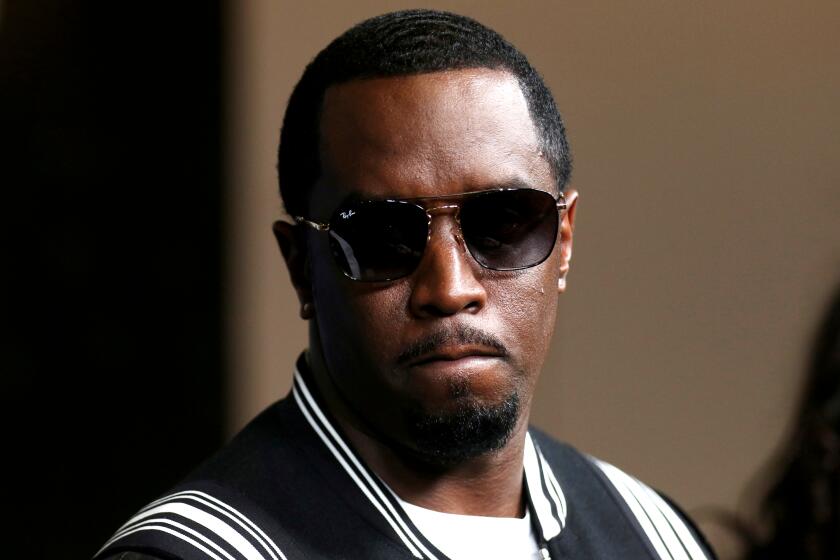Zakir Hussain’s stop will feature tablas for two
- Share via
Indian percussionist Zakir Hussain is a master of his homeland’s classical music and perhaps the genre’s most recognizable artist. But he’s also somewhat of an evangelist when it comes to exposing new audiences to the ancient musical craft.
The enthusiastic tabla player has reached a new demographic as a frequent collaborator with stars such as jazz fusionist John McLaughlin (they led the groundbreaking Indian-jazz group Shakti) and George Harrison, not to mention his long-term series of explorations with Grateful Dead drummer Mickey Hart.
In more than 40 years of performing regularly in the United States, particularly in leading his biennial all-star Masters of Percussion tours since 1996, the 61-year-old is thrilled with the way Western audiences now hear Eastern music.
“Playing in America is like playing in some parts of India,” says the Mumbai native, speaking from Trinidad in a prelude to the latest Masters edition, which comes to Walt Disney Concert Hall on Wednesday. “You see all these [Americans] sitting there, but the reactions coming from them [are] what I expect in Hyderabad and Chennai and Kolkata. They know the right time to smile, to exhale. They are experiencing exactly what I am going through onstage. It’s a great source of inspiration.”
With the current shows, Hussain is offering some new, challenging elements. A centerpiece of the tour is a set of rarely performed tabla duets pairing him with renowned Indian percussionist Fazal Qureshi. Various dates, including his L.A. stop, will also feature a bonus dance element with American choreographer Antonia Minnecola performing in the North Indian kathak style. These are family affairs — Qureshi is Hussain’s younger brother and Minnecola is Hussain’s wife.
Those extras complement the Masters’ typically eclectic mix of musicians from various regions and cultures of India and nearby. Joining Hussain and Qureshi are T.H.V. Umashankar, who plays the South Indian ghatam clay pot, Navin Sharma on the two-headed dholak drum, and Uzbekistan’s Abbos Kosimov on the doyra frame drum. Two melody instrumentalists, Rakesh Chaurasia on bamboo flute and Sabir Khan on the bowed sarangi, will also join them.
The tabla-times-two portion is particularly exciting to Hussain.
“What we discovered is there is about a 400-year-old documented repertoire written by the old masters for two tablas,” he says. “None of us was aware it was there. My brother, who teaches at the school our father [the late tabla icon Ustad Allarhaka] founded in Bombay, was going through old books and suddenly started coming across these compositions for two tablas and the alarm bells went off. And he looked for more and came across as many as 300. So I promptly incorporated this into the Masters of Percussion tour so we could try it. American audiences will be the guinea pigs!”
That duo’s set on this tour will be about 30 or 40 minutes, he says — far shy of the two-hour solo tabla performance that he often gives in India.
The dance performance by Minnecola also expands the horizons of the Masters presentation, with a traditional interpretation of a tale from an ancient Hindu epic, the “Ramayana,” detailing the abduction of goddess Sita.
“Tabla has a storytelling aspect, an expressive aspect,” Hussain says. “So we are having the dancer do a story. Each of us drummers will play a character. She will depict the characters visually and each drum will lend a voice to a character. That emotional aspect hasn’t been explored in detail onstage, so I am hoping we will be able to get somewhere with this and a whole new chapter of Indian drumming will emerge.”
Of course, while having confidence in the fans is crucial to these ventures, confidence in the musicians is more so.
“These are master drummers who don’t need to be told what to do,” he says. “I am looking forward to being onstage and enjoying. These guys are fabulous maestros and loved and revered in regions they come from, and I just want to share these great geniuses and their world with the audiences I’ve had the great fortune to play for over the years. They’ve heard me many times, but this will be a great chance and learning process for me.”
So some day can we expect a full two-hour solo performance here? He jokes that he may have to provide one, given how much red tape has become involved with getting visas for all of the musicians. But he’s starting to feel that the audiences here are ready. There’s even talk of something along those lines for an L.A. benefit concert later this year.
“I enjoy doing that,” he says. “So much fun to revisit the repertoire and to relive the time with my teacher, my guru, my father, who taught me that stuff when I was young.”
More to Read
The biggest entertainment stories
Get our big stories about Hollywood, film, television, music, arts, culture and more right in your inbox as soon as they publish.
You may occasionally receive promotional content from the Los Angeles Times.










